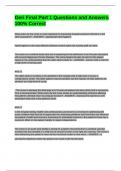Exam (elaborations)
Geri Final Part 1 Questions and Answers 100% Correct
- Course
- Institution
Geri Final Part 1 Questions and Answers 100% CorrectGeri Final Part 1 Questions and Answers 100% CorrectGeri Final Part 1 Questions and Answers 100% CorrectGeri Final Part 1 Questions and Answers 100% CorrectGeri Final Part 1 Questions and Answers 100% Correct100% Correct What action by the nurs...
[Show more]



